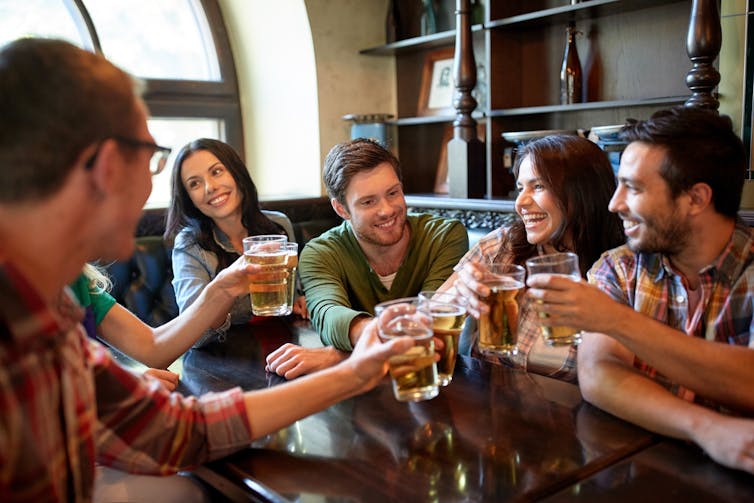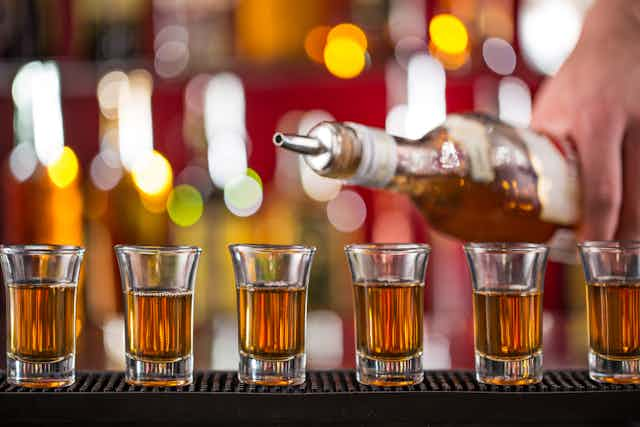People who admit to regularly binge drinking at the pub are more prone to have acted violently in the past 12 months, according to my new research. The findings raise questions about what strategies can be used to reduce alcohol-related violence and suggest promise for measures to modify alcohol pricing and taxation as well as restrictions on pub licences.
Due to its association with violent outcomes, binge drinking is an ongoing public health and criminal justice concern. Media coverage of binge drinking has focused on young people, given their frequent and often public displays of drunkenness. But young drinkers are not a homogeneous group and the overuse of the term “binge drinking” overlooks the complexity of their alcohol use. Understanding who people drink with and where helps give a fuller picture of the nuances of the way young people drink and whether it’s associated with violent behaviour.
Different types of drinkers
My research looked at data relating to more than 2,700 16 to 29-year-olds from England and Wales from the 2006 Offending Crime and Justice Survey to find out whether different typologies of drinkers exist and how these are associated with incidences of assault.
I used what’s called latent class analysis, a method for identifying subgroups within a population based on individual responses from large data sets. Using this method means this is the first study to describe the variation in young people’s drinking practices based not only on their alcohol consumption, but also who they drink with and where.
To do my analysis, I used three alcohol consumption measures based on the responses people gave to the 2006 survey. These captured whether respondents were weekly drinkers, had felt drunk at least once a month and whether they exceeded more than six units of alcohol in one day for women, or eight units for men – classed as binge drinking. I also used nine indicators of drinking context from the survey, which related to who people usually drank with and where. These included whether people drank with parents, partners, friends, relatives or work colleagues as well as whether they drank in pubs or bars, nightclubs, restaurants or on the street.
From this, three classifications of drinkers emerged, linked to the probability of a person committing assault offences in the past 12 months – also captured in the survey.
The smallest group – around 20% – were classed as “moderate drinkers”. They were characterised by low levels of drinking and had the lowest risk of perpetrating assault offences in the 12 months before they completed the survey.
They were followed by 32% of people classed as “regular pub binge drinkers”, who drank frequently and predominantly with friends in pubs. They had the highest probability of perpetrating assault offences in the past 12 months.
The largest group – around 48% – were classed as “regular social drinkers”. They drank frequently but across a wider range of settings with a wider range of people. Their likelihood of committing assault was lower than the regular pub drinkers but higher than the moderate drinkers.

Strategies to reduce violence
These findings support the notion that drinking behaviour is influenced by the setting in which alcohol is consumed – which can then impact the likelihood of violent behaviour. As the survey did not ascertain whether the violence that occurred did so under the influence of alcohol or not, it remains a possibility that people who are violent are more likely to binge drink, rather than the other way round.
While this kind of study does not imply that drinking causes violence, when these findings are considered alongside those of other studies, they help support the theory that alcohol intoxication facilitates violence among some people in some contexts.
The findings suggest that generic campaigns to reduce drinking, such as the law that introduced a minimum price for a unit of alcohol in Scotland, are still worthwhile. But so are targeted interventions specific to the drinking context, for example making sure staff in pubs and clubs do not serve people who are drunk, as well as limiting the availability of alcohol by restricting licenses and pub trading hours. In England, research suggests that areas with more intense alcohol licensing policies have shown stronger declines in rates of violent crimes.
This means that attempts to ameliorate alcohol-related violence ought to be specific to the context in which the drinking occurs, rather than just focusing on reducing drinking frequency or the amount of alcohol consumed.

